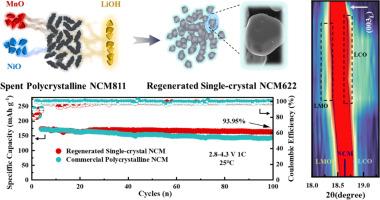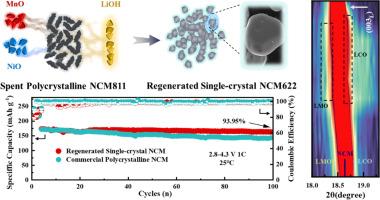废NCM811相组分均质再生成单晶NCM622,增强了结构和电化学稳定性
IF 20.2
1区 材料科学
Q1 CHEMISTRY, PHYSICAL
引用次数: 0
摘要
废旧电池的回收利用具有巨大的经济和环境价值,已受到广泛关注。直接再生作为一种经济高效的再生方法,近年来在锂离子电池可持续回收领域备受关注。然而,由于多相复杂性和严重的结构降解,直接再生对废高镍阴极的实际应用仍然受到限制。本文提出均质相组分再生技术(HPCR),实现了废多晶NCM811向单晶NCM622的转化,提高了NCM811的结构稳定性和电化学稳定性,同时解决了上述问题。通过控制高温烧结和元素再平衡,实现了均匀的颗粒形貌,降低了Li/Ni无序性,抑制了氧空位。再生阴极的容量为163.0 mAh g⁻¹,在1.0 ℃下循环100次后的保留率为93.9%,满足商业系统的需求。密度泛函理论和电化学分析表明,最小的缺陷浓度促进了Li⁺的扩散和结构完整性。重要的是,揭示了NCM811向NCM622的生长机理,显示了清晰的相变和重要元素扩散过程。总的来说,这项工作为废NCM811的同质再生提供了一种有效且可扩展的策略,并得到了清晰揭示的再生机制的支持。本文章由计算机程序翻译,如有差异,请以英文原文为准。


Homogenizing phase–component regeneration of spent NCM811 into single-crystal NCM622 with enhanced structural and electrochemical stability
Capturing the great economic and environmental value, the recycling of spent batteries has been devoted to numerous attentions. As a cost-effective and energy-efficient approach, direct regeneration has attracted considerable attention in recent years in the field of sustainable lithium-ion battery recycling. However, the practical application of direct regeneration to spent high-nickel cathodes is still limited due to multiphase complexity and severe structural degradation. Herein, the homogenizing phase-components regeneration (HPCR) was proposed, achieving the transformation from spent polycrystalline NCM811 to single-crystal NCM622 with enhanced structural and electrochemical stability, which simultaneously solved the issues above. Through controlled high-temperature sintering and element rebalancing, uniform particle morphology, reduced Li/Ni disorder, and suppressed oxygen vacancies are achieved. The regenerated cathode delivers a capacity of 163.0 mAh g⁻¹ with 93.9 % retention after 100 cycles at 1.0 C, meeting the demand of commercial systems. Density functional theory and electrochemical analysis reveal that minimized defect concentrations promote Li⁺ diffusion and structural integrity. Significantly, the growth mechanism from NCM811 towards NCM622 was disclosed, showing the clear phase transformation and vital elements diffusion process. Overall, this work provides an effective and scalable strategy for the homogeneous regeneration of spent NCM811, supported by a clearly revealed regeneration mechanism.
求助全文
通过发布文献求助,成功后即可免费获取论文全文。
去求助
来源期刊

Energy Storage Materials
Materials Science-General Materials Science
CiteScore
33.00
自引率
5.90%
发文量
652
审稿时长
27 days
期刊介绍:
Energy Storage Materials is a global interdisciplinary journal dedicated to sharing scientific and technological advancements in materials and devices for advanced energy storage and related energy conversion, such as in metal-O2 batteries. The journal features comprehensive research articles, including full papers and short communications, as well as authoritative feature articles and reviews by leading experts in the field.
Energy Storage Materials covers a wide range of topics, including the synthesis, fabrication, structure, properties, performance, and technological applications of energy storage materials. Additionally, the journal explores strategies, policies, and developments in the field of energy storage materials and devices for sustainable energy.
Published papers are selected based on their scientific and technological significance, their ability to provide valuable new knowledge, and their relevance to the international research community.
 求助内容:
求助内容: 应助结果提醒方式:
应助结果提醒方式:


